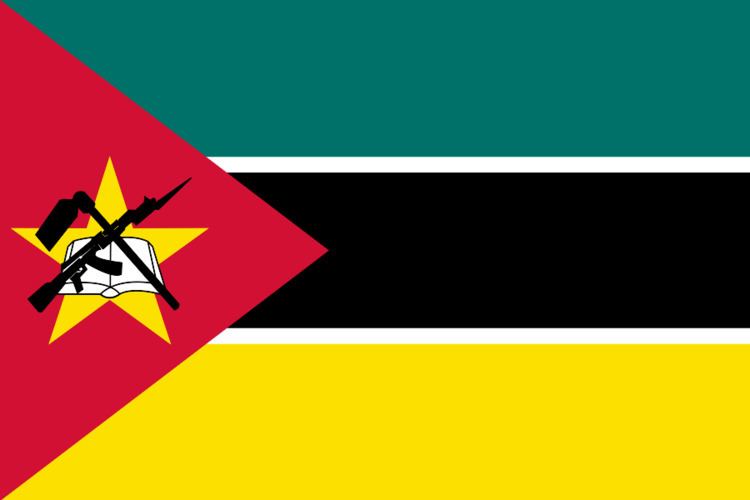Population 25.83 million (2013) GNI per capita 1,100 PPP dollars (2013) | Life expectancy 49.84 years (2012) Population growth rate 2.5% annual change (2013) | |
 | ||
Fertility rate 5.26 births per woman (2012) | ||
The demographics of Mozambique describes the condition and overview of Mozambique's peoples. Demographic topics include basic education, health, and population statistics as well as identified racial and religious affiliations.
Contents
- Map of Mozambique
- Population
- Vital statistics
- Fertility and births
- Ethnic groups
- Languages
- Culture
- Education and health
- CIA World Factbook demographic statistics
- References
Map of Mozambique
Population
According to the 2010 revision of the World Population Prospects the total population was 23 391 000 in 2010, compared to only 6 442 000 in 1950. The proportion of children below the age of 15 in 2010 was 44.1%, 52.6% was between 15 and 65 years of age, while 3.3% was 65 years or older .
Vital statistics
Registration of vital events is in Mozambique not complete. The Population Departement of the United Nations prepared the following estimates.
Also, according to a 2011 survey, the total fertility rate was 5.9 children per woman, with 6.6 in rural areas and 4.5 in urban areas .
Fertility and births
Total Fertility Rate (TFR) (Wanted Fertility Rate) and Crude Birth Rate (CBR):
Fertility data as of 2011 (DHS Program):
Ethnic groups
Mozambique's major ethnic groups encompass numerous subgroups with diverse languages, dialects, cultures, and histories. Many are linked to similar ethnic groups living in inland countries. The estimated 4 million Makua are the largest ethnic group of the country and are dominant in the northern part of the country — the Sena and Shona (mostly Ndau) are prominent in the Zambezi valley, and the Shangaan (Tsonga) dominate in southern Mozambique. Other groups include Makonde, Yao, Swahili, Tonga, Chopi, and Nguni (including Zulu). The country is also home to a growing number of white residents, most with Portuguese ancestry. During colonial rule, European residents hailed from every Mozambican province, and at the time of independence the total population was estimated at around 360,000. Most vacated the region after independence in 1975, emigrating to Portugal as retornados. There is also a larger mestiço minority with mixed African and Portuguese heritage. The remaining Caucasians in Mozambique are primarily Indian Asiatics, who have arrived from Pakistan, Portuguese India, and numerous Arab countries. There are various estimates for the size of Mozambique's Chinese community, ranging from 1,500 to 12,000 as of 2007.
Languages
Portuguese is the official and most widely spoken language of the nation, but in 2007 only 50.4% of Mozambique's population speak Portuguese as either their first or second language, and only 10.7% speak Portuguese as their first language. Arabs, Chinese, and Indians speak their own languages (Indians from Portuguese India speak any of the Portuguese Creoles of their origin) aside from Portuguese as their second language. Most educated Mozambicans speak English, which is used in schools and business as second or third language.
Culture
Despite the influence of Islamic coastal traders and European colonizers, the people of Mozambique have largely retained an indigenous culture based on smallscale agriculture. Mozambique's most highly developed art forms have been wood sculpture, for which the Makonde in northern Mozambique are particularly renowned, and dance. The middle and upper classes continue to be heavily influenced by the Portuguese colonial and linguistic heritage.
Education and health
Under Portugal, educational opportunities for poor Mozambicans were limited; 93% of the Bantu population was illiterate, and many could not speak Portuguese. In fact, most of today's political leaders were educated in missionary schools. After independence, the government placed a high priority on expanding education, which reduced the illiteracy rate to about two-thirds as primary school enrollment increased. Unfortunately, in recent years school construction and teacher training enrollments have not kept up with population increases. With post-war enrollments reaching all-time highs, the quality of education has suffered. As a member of Commonwealth of Nations, most urban Mozambicans are required to learn English starting high-school.
CIA World Factbook demographic statistics
The following demographic statistics are from the CIA World Factbook, unless otherwise indicated.
Population:
Population growth rate:
Sex ratio at birth: 1.03 male(s)/female (2003 est.), 1.02 male(s)/female (2007 est.)
under 15 years: 0.98 male(s)/female (2003 est.), 1.01 male(s)/female (2007 est.)
15-64 years: 0.95 male(s)/female (2003 est.), 0.949 male(s)/female (2007 est.)
65 years and over: 0.7 male(s)/female (2003 est.), 0.717 male(s)/female (2007 est.)
total population: 0.96 male(s)/female (2003 est.), 0.968 male(s)/female (2007 est.)
Life expectancy at birth:
total population: total population: 51.78 years
male: male: 51.01 years
female: female: 52.57 years (2011 est.)
HIV/AIDS — people living with HIV/AIDS: 1.4 million (2009 est.) HIV/AIDS — deaths: 74,000 (2009 est.)
Nationality:
noun: Mozambican(s)
adjective: Mozambican
Ethnic groups:
Indigenous tribal groups (including the Shangana, Chokwe, Manyika, Sena, Makua, Ndau, among others) make up 98.61% of Mozambique's total population. People of mixed race are the largest minority, totaling 0.84% from the remaining figure, while Portuguese Mozambicans and Mozambicans of Indian descent represent 0.36% and 0.2% of the population respectively . There are noteworthy Chinese and Arab communities.
Languages: Portuguese language (official)
Emakhuwa 26.1%, Xichangana 11.3%, Portuguese 8.8% (official; spoken by 27% of population as a second language), Elomwe 7.6%, Cisena 6.8%, Echuwabo 5.8%, other Mozambican languages 32%, other foreign languages 0.3%, unspecified 1.3% (1997 census)
Literacy:
definition: age 15 and over can read and write
total population: 47.8% (2003 est.), 40.1% (1995 est.)
male: 63.5% (2003 est.), 57.7% (1995 est.)
female: 32.7% (2003 est.), 23.3% (1995 est.)
